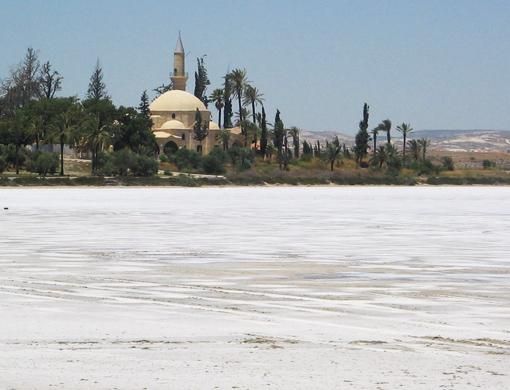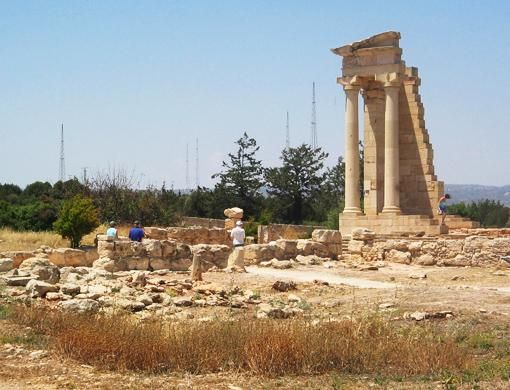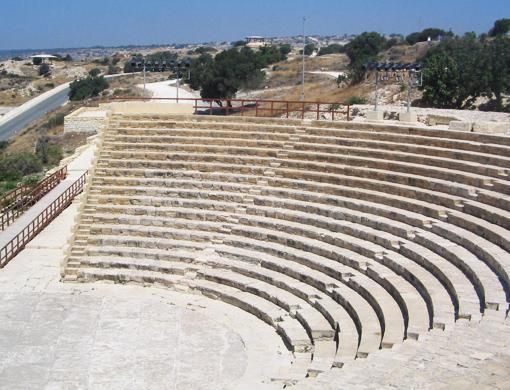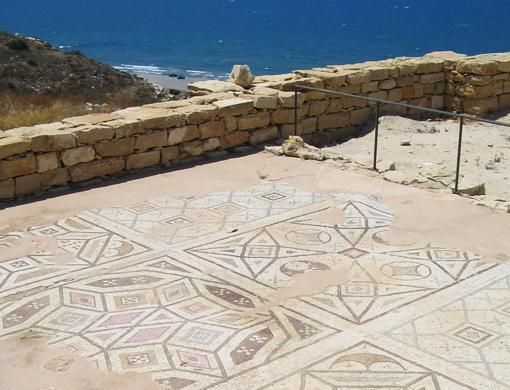There can be few mosques in the world with a setting more beautiful than that of Hala Sultan Tekkesi.
The building is surrounded by dozens of date palms and cypress and olive trees, while in front sits a huge salt lake, a bright white sheet with occasional patches of water.
And behind it, in the distance, sit the multicoloured hills and mountains of central Cyprus. It is, quite simply, breathtaking.
What makes it all the more remarkable is that the mosque, located in the south-east of Cyprus, is just a half-hour walk from the island's busiest airport.
First things first
Hala Sultan Tekkesi was built in 674 after Umm Haram, said to be the aunt of the Prophet Mohammad (PBUH), fell from her mule and died.
Her tomb lies in an annexe next to the mosque, which is open to non-Muslims and is the first thing most people see when they arrive on that Mediterranean island.
While Cyprus is popular with package holidaymakers keen to spend a couple of weeks lying in the sun and partying, there is more to the island than the beaches and nightclubs it is famous for.
Touch of the past
The town of Larnaka, near the mosque, is a pleasant seaside resort with an attractive, long seafront that is a popular place for evening walks.
Like the mosque, it is in the Greek part of Cyprus, which covers about two thirds of the island's area.
Keen to see some of the island's other historical highlights, I headed west to Lemesos, also known as Limassol, from where I took a bus to ancient Kourion, described as Cyprus's premier archaeological site.
Ancient wonder
The site was probably founded in Neolithic times, but the remains that people arrive by the coachload to see are much more recent.
The most attention-grabbing part of the site is the amphitheatre, which is a reconstruction of a smaller theatre destroyed in a 3rd-century earthquake.
Beside the amphitheatre, with its glorious setting overlooking the sea, are the mosaics of the Annexe of Eusolios, a 5th-century private house. Tourists crowd around here.
Kourion also contains an early Christian basilica that dates from the 5th century and, while it is very much a ruin, it is still possible to identify the various parts of the building, such as the atrium, nave and bishop's house.
Motley mix
Behind this is the House of Gladiators, which has some wonderful mosaics of gladiators in combat.
On leaving Kourion, I walked beside a busy coast road to reach the Sanctuary of Apollon Ylatis, which dates back to the 8th-century BC. Apollo was the Greek god of medicine and healing.
Just a few columns from the Roman times are standing now.
Nearby is a huge stadium that is said to have had space to seat 6,000 people in its heyday. There was no one else there when I visited and it was strange to stand in the silence and imagine the hive of activity the stadium must have once been.
Further west, in Cyprus's south-west corner, lies the city of Pafos. It has a nice enough centre, but most of the activity happens at the coast at Kato Pafos, the tourist town.
Kato Pafos is full of nightclubs and restaurants and at night its neon-lit streets teem with sunburnt Europeans. Within walking distance of the rather tacky tourist area is a large archaeological site with Roman mosaics that are the equal of any you can find in the Mediterranean region.
There is a huge shed-type structure built on top of the mosaics with wooden walkways from where I was able to look in detail at the creations.
Among the best is the mosaic of Narcissus, the vain youth from Greek mythology who only had eyes for himself. He is seen staring at his reflection in the water.
Equally memorable is the mosaic showing a young man, Hippolytos, and his stepmother, Phaedra, who fell in love with him. Their tale ended tragically, with both dying.
Many faces
Another highlight of the place is the Four Seasons mosaic, which shows winter as an old man with a beard and summer wearing ears of corn and holding a sickle.
The other major attraction that no one visiting Pafos should miss is the area of Tombs of the Kings. The designs of these tombs are said to have been influenced by Egyptian architecture.
This Unesco World Heritage Site was where the top echelons of Pafos society were buried between the 3rd-century BC and the 3rd-century.
Several tombs scattered beside the sea have been excavated, and people can walk down large stone steps into them. There are huge Doric columns and recesses where the bodies used to lie.
Standing in the middle of one of the tombs, it was hard to believe that just a few minutes' drive away sat Kato Pafos in all its tacky glory.
Cyprus, with its package holiday-nightmare resorts and stunning historical sites, is certainly an island of contrasts.
Cyprus from the UAE
From Dubai
Middle East Airlines flies daily via Beirut. Fare:Dh2,650
Gulf Air flies four times a week via Bahrain. Fare: Dh1,250
From Abu Dhabi
Royal Jordanian flies three times a week via Amman. Fare: Dh1,810
Gulf Air flies three times a week via Bahrain. Fare: Dh1,250
(All fares exclusive of taxes)
Information courtesy: MMI Travel
Information
I flew from Dubai to Larnaka via Kuwait with Jazeera Airways (www.jazeeraairways.com).
Where to stay
In Larnaka I stayed at the Hostelling International (HI) Hostel (Tel: 00357-4621188), where a dormitory bed was Cyprus£5 (Dh43) per night. In Lemesos a room with its own balcony, at the Luxor Guest House (Tel: 00357-5362265) cost Cyprus£10 (Dh86), while in Pafos, I stayed at the Trianon Guest House (Tel: 00357-6232193) for Cyprus£8 (Dh69) per night.



















